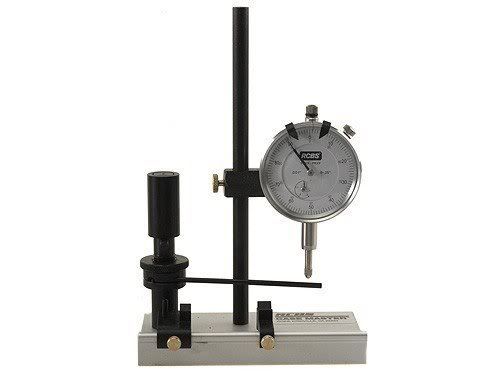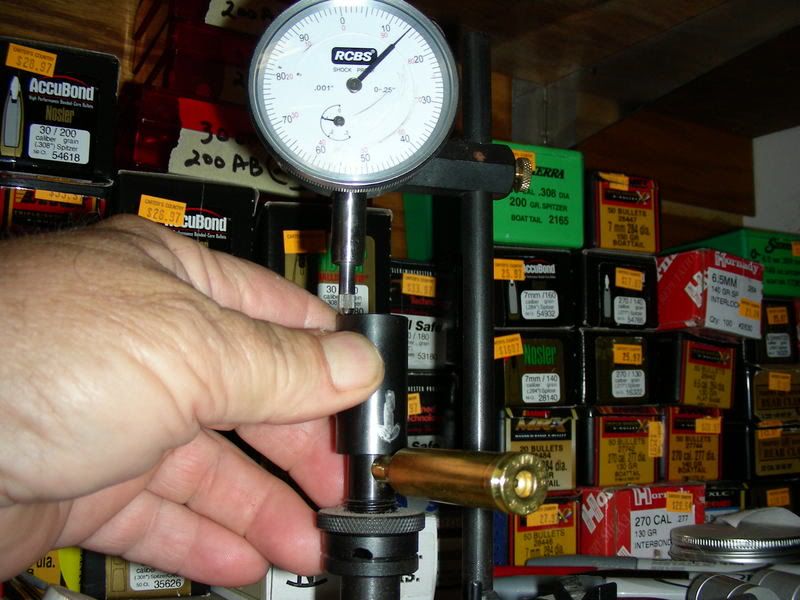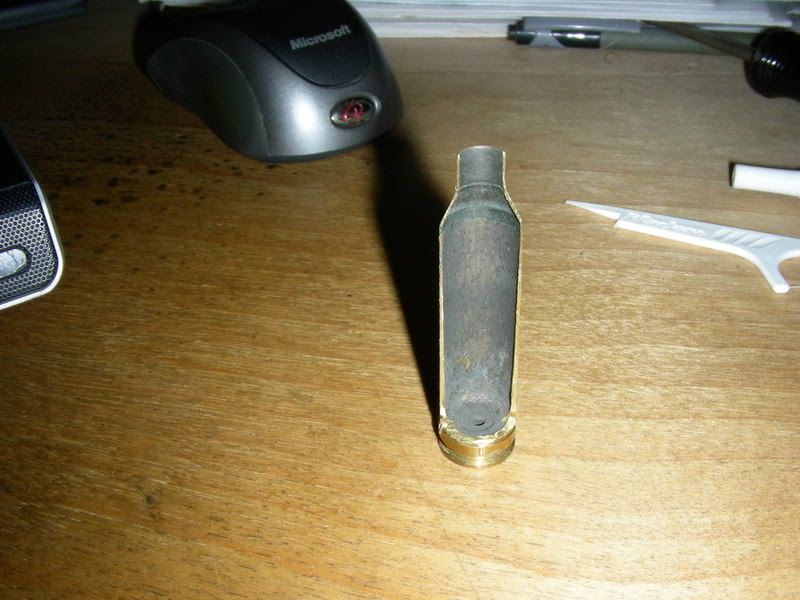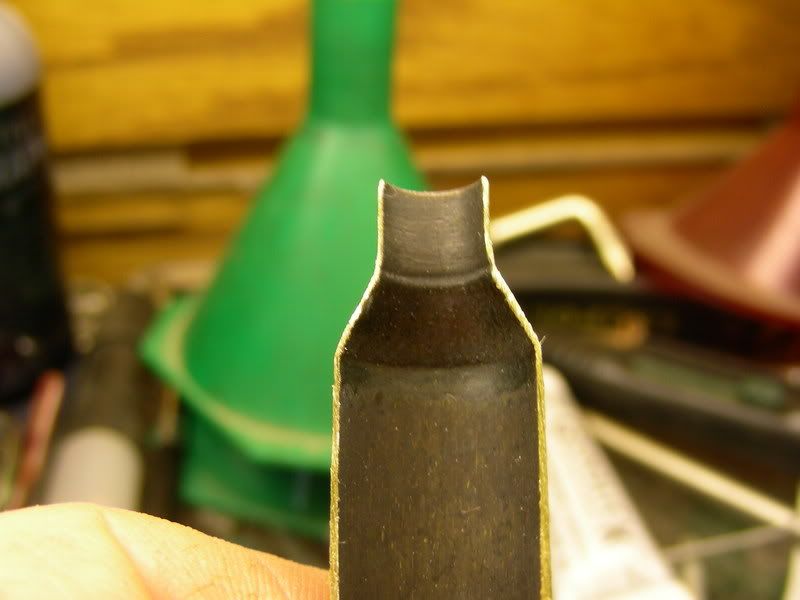----
I just got a new gadget. A Hornady neck turning tool.
I have practiced with 30-30 cases (seems I have a bunch of range pickups and goof ups laying around) and have figured out how to make pretty cuts down the length of the looong neck. I plan on using this primarily on my 300 Win Mag, 7mm Rem mag, and occasionally on my "seems" to be tight chambered 22-250. (With the 30-30 I have no really big need, but I might just for the fun of it.)
I have come come up with:
1. Clean in my normal fashion.
2. Anneal ( I ran into problems with the brass "springing " back and binding on the mandrel, The tech at hornady and I sat down and figured this one out.)
2. Re-size
3. clean the inside of the case neck as icky stuff seems to build op on the mandrel causing it to bind and unscrew the mandrel thus losing my neck length adjustment on the mandrel.
4. ????
5. Trim the brass if neccessary, I plan on doing this last in the event I advance a little bit to fast and knick the case mouth, this may help in removing the knick.
I just have know real Idea on sorting and measuring. This tool does a wonderful job of evening out the neck wall and reducing the neck O.D.
I am not using match chambers so it's probably not that big a deal for me to have a slight difference in O.D. I am primarily trying to achieve a uniform tension from the neck and crimp.
Also, I plan on starting my loads over until I find out I am not cutting to deep into the wall (causing splits) or weakening the point where the neck meets the shoulder (causing a slightly more annoying problem)
I was also curious if you folks have any general specs for wall thickness, I don't have access to a large amount of sammi cartoons and the thicknesses on all of the brass I have measured so far differs enough to where I don't know where to judge. I have just started to take off as little as possible in order even the walls.
----
I don't have any "tight neck" rifles, so I only turn necks enough to make them concentric.
----
I buy good brass and have never felt your pain........
----
Most of my rifles have commercial chambers and i never have had a problem. I neck size and leave part of the neck unsized to help center the round in the chamber. It must work because I typically shoot sub-MOA groups with all my rifles.
----
Sleep deprivation and brain farts....
I answered one of my own questions, neck O.D. should be the same if the walls are even throug out the lot and the bullet is round and of cosistant o.d. I loaded a pulled(destroyed) bullet in a piece of brass that I nicked the shoulder on, and it expanded the next out nicely.
I imagine if I sort by wall thickness I should be ok. I am curious though as as the lower limit of wall before the neck will split out. Safety first, accuracy second. a damaged gun isn't accurate.
----
Hey jbird
I have 3 rifles I have to turn the necks on and generally turn other brass. The general consensus is not to turn neck thickness lower than .010".
Brass will vary widely in neck thickness. It would be helpful if you can measure the neck thickness so you will know what you are dealing with. There are generally 2 methods for measuring, the RCBS Casemaster


and a ball micrometer

I prefer the RCBS Casemaster because it is easier to use. It will also measure concentricity so if you are getting something to measure your neck thickness you might as well get one of those and kill 2 birds with 1 stone.
Brass will vary widely in neck thickness and neck thickness variance. I have to turn for a tight necked 6.5 rem mag and the Remington brass for it varied from .015" to .017" and my chamber neck is only .292". Going through the math .292"-.003"(recommended chamber clearance)=.289"-.264"(caliber)=.025"/2=.0125". You have to divide by 2 to get the thickness on each side. That means I have to turn from .015"+ down to .0125", that's a lot of turning and there were brass shavings everywhere.
By contrast, in my 280AI with a .313" neck the Nosler brass is very consistant and varies from .0135" to .014", so I only have to turn 1/1000" off of it or so.
You can measure your brass thickness and chamber neck dimensions with a regular caliper. Your chamber neck is just the outside neck measurement of a fired and unsized case. Your neck thickness is the outside of a loaded case minus the caliber divided by 2. For instance if your 300 win mag loaded round outside neck diameter is .336" the the math is .336"-.308=.028"/2=.014". Now that method will not tell you if you are thicker on one side than the other. Then if your fired and unsize case measures .342" then you know you have .06" clearance around your case neck if all your brass is consistantly .014" thick.
Turning necks will help with your accuracy, just how much is widely disputed. I think it has some effect on bullet release because with a piece of brass that is .015" on one side and .013" on the other, the brass may expand for bullet release at a different rate and other factors such as chambering pressure may lead to an increase in bullet runout. IMO it has about the same amount of influence on accuracy as other small factors such as weight sorting brass and bullets or crimping.
With a hand turner it is important that you have a tight fit on the mandrel. That is why with the very best turners like the K & M you buy an expanding mandrel to get it right. For me since I neck size with a Lee Collet that preps my case neck just right for my Forster hand held turner. The mandrel has to be forced in slowly while turning. I like to get a complete turn so material is removed all the way around


but that is my preference. Others may only turn to hit the high spots. IME that does not take enough off to even measure. Notice on that last pic how I turn a little into the shoulder, this is supposed to mitigate donut development.
Turn new brass and you only have to do it once. YMMV
----
Thanks Woods! Good explanation and good pics!
----
I neck trim my Whisper down to 0.11
It wont chamber otherwise

----
Wow!, Thank you for such a great explanation. You opened up my brain so that it wrapped could be wrapped around this endeavor. This is fun an I appreciate the information so I can understand what, why, and how it all ties in together.
I took 5 pcs of my fired 300 Win brass and measured for the average OD of each neck and then averaged those averages. depending on where I measured the neck it stayed at about .341 give or take .00025 I can live with that until I get around to buying some cerosafe and casting the chamber.
.341-.003=.338 for the targeted O.D.
.338-.308=.030
.030/2=.015 for a target wall. This wall is close to the wall of the unsized brass so I figure that I should just have to "clean" them up a bit.
I have been tempted by the rcbs case gage and may have another reason to purchase it. I used my dial calipers to measure some different pieces of brass and found that occasionally certain types of factory crimp was still present after trimming and this in turn provided bad readings. I kind of like the idea over the the ball mic. I use these buggers at work and usually end up switching out to a mitutoyo uni-mic because of differences in readings.
You included a nice picture of a finished case with provisions to fight the "dreaded doughnuts" I will have to play with my cutter to see it I can get it to cut like that. My cutter bit hits at a light angle providing a clean cut but also keeps the angled portion of the bit away from the shoulder leaving a per' near 90 degree cut at the shoulder, or at least om my 30-30-brass. I will have to look into this a bit more. I already figured out that I have to anneal the brass or it snaps back out of round, this has a potential for not cutting even. It still will be tight - about .002 between mandrel and expander sizes.
I have heard this dreaded doughnut term before. I just now started looking at what exactly it is. After reading a few online articles on removing them and using a bullet or a gage pin in a fired case to find them. I discovered that it is a wring of brass where the the shoulder meets the neck.
[align=center]"Hot loaded" Image - www.the-long-family.co...t.jpg.[br]

[align=left]
I am curious what exactly does this do? I mean to hurt me. I could see an increased drag resulting in a higher pressure, but if not working at top of the pressure scale, I don't see to much of a problem. It could I suppose cause a a slight velocity or accuracy variation by acting the same as inconsistent case necks/crimps. Or I suppose I might just not get the bullet in there.
I figured I might be able to get a reamer or modify and shorten a drill bit to combat this phenomenon but was curious if it was that big of deal. I am willing to go down this road because I have already spent the money on the neck turner. I am trying to send my very best work as a gift more Mr. and Mrs. Whitetail. as well as produce the most accuracy possible out of my guns.
Thanks again, Woods for such a thorough explanation. It could almost be an article on the subject.
----
I'm not sure about your reference to annealing. Neck turning is always done on new brass before firing except I have seen a couple of posters say that they do it after once firing. The brass should be soft on new cases and any annealing that makes them softer would be a problem. Also, annealing generally increases brass springback, not decreases. For example, the reason that you can fire a case 3 or 4 times before it gets tight in the chamber is because it springs back less and less after each subsequent firing because it is getting hardened by working. Annealing several times fired brass will give it back it's original springback characteristics.
You have the math just right on the .015" per side. IMO if you wanted to take each side down to .0145" in order to get a complete neck turn then that would only increase chamber neck clearance to .004" and would not make a noticeable difference. Personally, I like to get a complete clean all the way around, especially if I am going to have plenty of brass left like .014". It's down below .012" where I might do a partial clean.
The dreaded donut!

Therefore I would postulate that most if not all cases in all guns have the donut and it is of no consequence because when resizing the necks, the brass in the neck is pushed in to a smaller diameter than the donut which is as much in the shoulder as it is in the neck. I hope I'm making sense. After resizing you can no longer push a bullet down the neck and check for the donut and like I say it may no longer be there since the neck brass may have been pushed past it to a smaller diameter. Something to think about.
The donut may have a consequence in a tight necked chamber or if it is large enough to stop a bullet in a fire formed neck. Then it will bear on the bullet. A seating die will push the bullet right past it with no problem. Seems like it would act like an inside crimp like you said and if it does one can only hope that the donut is uniform all around, otherwise there could be bullet release consistancy problems.
The way I get around it in my factory guns is to put a washer around the case head on top of the shell holder when I am sizing the neck with a Lee Collet

This will keep a portion of the neck fire formed or chamber size on the neck just forward of the shoulder and keep the donut from bearing on the bullet, at least in theory. On the split case in the pic above had that section left fire formed but that happens because the custom Lee Collet they sent me does not size the neck all the way down to the shoulder


K & M makes a mandrel for their neck turner that has a drill on the end and will remove the donut. They also sell the expanders that will expand the neck to the exact size needed for the neck turner mandrel. On my Forster the madrel is really tight and will scratch grooves into the inside neck

but I always polish the inside of the neck with steel wool and remove all those burrs and scratches from chamferring and neck turning

----
The concept of annealing is brought out by me trying to turn brass that is once fired or brass reclaimed from cartridges that are up to 20 years old. I have large assortments of brass of which is once fired from my guns or range pick ups. Anealing can't but help these cases, espcially the aged ones, any way.
I have new brass that I agree is soft enough to start and would not need to be annealed.
Die settings. Someone else has pointed out the idea of leaving a small portion of the neck unsized. as well as you. This is food for thought. I will try this on some of my cases in the future. This may already happen with my magnum dies as I was taught to head space of the shoulder rather than the belt. I set the full legnth dies so that the action just closes and then a bit more to adjust for potential problems associated with a dirty chamber. This is more that likely a a different conversation in which I will monitor for a while.
The doughnut. I will monitor this in the near future. I have not sized many cases for the 300 win as other cartridges. I just frankly can't take the beating required to shoot this in high volume. (6 rounds a week at most.) and so far all of my smaller cartridges haven't caused me enough concern or worry. My 30-30 groups around 2 MOA at 100 yds and therefor I really don't care about that one. But I will watch closely on my 22 cal guns. especially as I may be reaching the higher end of the pressure spectrum with these. I will monitor for them existing donuts but I won't worry to hard until I know it is a problem or I get around to building my dream long range bolt gun. (always under development and subject to capital resources.)
I appreciate your help. I will designate some cases for more "special" use on my 22-250,223, 7mm Mauser, and maybe even a few 30-30s out of my new lots of brass and turn them. I will also turn every one of my new magnum cases.
----
| jbird22cal wrote: |
| : Die settings. Someone else has pointed out the idea of leaving a small portion of the neck unsized. as well as you. This is food for thought. I will try this on some of my cases in the future. This may already happen with my magnum dies as I was taught to head space of the shoulder rather than the belt. I set the full legnth dies so that the action just closes and then a bit more to adjust for potential problems associated with a dirty chamber. This is more that likely a a different conversation in which I will monitor for a while. |
Forster has a die that does this www.forsterproducts.co...n_dies.htm

Headspacing on the shoulder with your FL dies will not accomplish this if you are sizing the case body or shoulder at all. However if you set your full length die to size about 3/4 of the neck and not touch the case body or shoulder then it will do the same thing. If you have a crush fit and need to push the shoulder back then the FL die will size all of the neck before it is set far enough to push the shoulder back.
----
Woods,
I do that with my neck sizing dies just by adjusting the die. I am not forming the case though - just reloading.
----
Thanks, I'll play around with my dies to see if I can get some satisfactory results with them. If not I guess I'll have to look at the dies you mentioned.
----
Just adjust your neck sizing die so that it leaves a bit of the neck unsized. I don't own any "special" dies. You may be able to do the same with a full length die set but it may partially size the body of the case and leave you with a loose fit in the chamber.
All times are GMT - 7 Hours